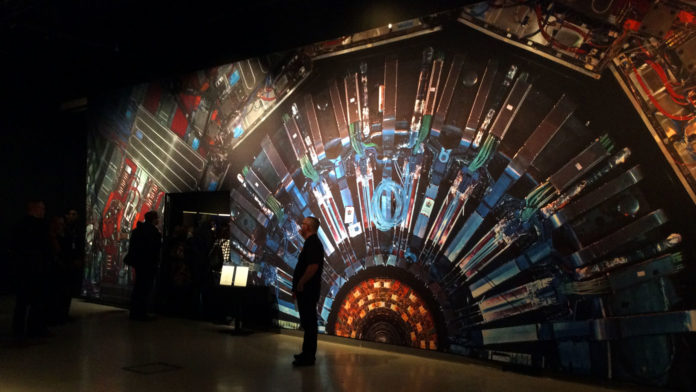Many visitors to the Cultural Collisions exhibit say that walking through its doors feels a bit like entering a cathedral.
An epic photograph of the CMS Detector at CERN, an instrument that looks for signs of new subatomic particles 40 million times each second, looms large over its entryway. These experiments approach conditions similar to those that existed just after the Big Bang, and they probe questions about the very nature of our universe and its origins.
But while these experiments have united researchers worldwide, bringing together over 200 research institutes, universities, and laboratories from more than 40 countries, that’s not the focus of the exhibit. That’s just the framework that sets the stage for its true goal: to use art to inspire visitors, and especially young students, to immerse themselves in physics.
The exhibit is running for just one week at the Ontario Science Centre, but it will leave a lasting impact on the many students who are participating in its interactive sessions. They are being introduced to complex science concepts in some of the most fun ways imaginable: through dance, music, and art.
The facilitators have students dancing to understand particle spin, and collaborating on lyrics to perform live with a beatboxing rapper.
More particles in action at #Cultural_Collisions at @OntScienceCtr! @CMSexperiment @ArtatCMS @CERN @IDIOntario pic.twitter.com/6J7GLcTJV9
— Mishaal Surti (@MrSurti) April 9, 2018
These students are going to walk away and use this experience to keep experimenting with ideas, creating their own artistic representations of what they learned. These interpretations will form their own exhibit at the Ontario Science Centre in June.
And according to CERN physicist and photographer Michael Hoch, founder of art@CMS, it hardly matters what students come up with in the end. What is most important here is the process: the insights that can be gleaned from their sketchbooks, the evolution of their thought processes, and the ideas that will eventually be woven into their final work.
Fortunately, they will have no shortage of inspiration to draw from. CMS, short for the Compact Muon Solenoid, detects debris from high energy collisions of particles at the Large Hadron Collider, the largest and most powerful particle accelerator ever built.
The particle accelerator can be thought of as the strongest and biggest microscope that humankind has ever used, says Hoch. To penetrate electrons and nuclei, particles that were once thought to be indivisible, an accelerator was needed. It allows researchers to make particles collide head-on, breaking them apart and studying their debris.
Looking for these particles requires huge amounts of energy, but the reward is a fleeting view into the components that make up our universe: a portal into our origins, what is going on in our stars, and even into what came before it all existed.
This is a view we’re looking forward to seeing focussed through the eyes and minds of local students.
Cultural Collisions is on exhibit now, closing after this weekend on April 15, 2018 at the Ontario Science Centre.








































